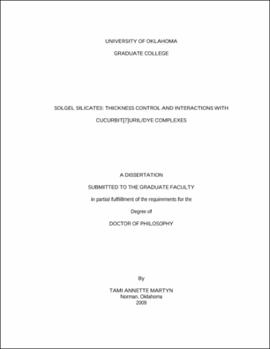| dc.contributor.advisor | Yip, Wai Tak | |
| dc.creator | Martyn, Tami | |
| dc.date.accessioned | 2019-05-01T17:24:36Z | |
| dc.date.available | 2019-05-01T17:24:36Z | |
| dc.date.issued | 2009 | |
| dc.identifier | 99134597202042 | |
| dc.identifier.uri | https://hdl.handle.net/11244/319474 | |
| dc.description.abstract | This work reports the progress made in investigating the versatility of solgel silicate thickness control and hosting capabilities for use in sensor and optical material technologies. Thickness control of the solgel silicate was obtained by absorbing the silicate into a biocompatible polyelectrolyte multilayer thin film scaffold. The composite structure is capable of maintaining its porosity, which allows external stimuli to access the interior of the film. In hopes of improving upon dye survival lifetime and brightness, complexation of cucurbit[7]urils (CB7) with the cationic dye molecules, rhodamine 6G (R6G) and pyronin Y (PyY), was investigated. Favorable results found with the R6G/CB7 and PyY/CB7 complexes led to the introduction of the complexes to the optical material. | |
| dc.description.abstract | Since CB7 complexation enhances the emission intensity and photostability of R6G in solution, CB7-complexed R6G was analyzed using single molecule fluorescence spectroscopy in an effort to better understand how CB7 interacts with R6G, and the related molecule Pyronin Y, to enhance emission intensity and photostability. Electrostatic attraction between CB7 and cationic dye molecules, R6G and PyY, give the complexes high association constants in solution. The barrel shape of CB7 has an electronegative ring of oxygens at the cavity portal, which attract the positive charge of the dye molecules. However, R6G, a well-known and commonly used laser dye, is too large to be fully included into the CB7 cavity. Single-molecule measurements showed a wide distribution of emission intensities from individual R6G/CB7 complexes. The concurrent changes in polarization and intensity indicate the R6G molecule is moving in relation to the CB7 cavity, causing a reduction in emission intensity as R6G leaves the CB7 cavity. Furthermore, the changing emission intensity of individual R6G/CB7 complexes demonstrates the broad intensity distribution is not merely a collection of different static intensities, but includes complexes with dynamic motion which leads to different emission intensities for each complex. | |
| dc.description.abstract | The incorporation of CB7-complexed R6G into a solgel silicate matrix was intended to combine the photostability enhancement that solgel silicates can provide with the intensity enhancement dye to complexation with CB7. However, R6G/CB7 and PyY/CB7 complexes had substantially different emission properties with the immobilization matrices used than they possessed when spincoated without a matrix. R6G/CB7 in an alcogel thin film emitted similarly to R6G alone in the alcogel thin film, both in emission intensity and survival lifetime. PyY/CB7 on a PAH monolayer emitted midway between the PyY on PAH and PyY/CB7 without a matrix. Both dye molecules had the highest emission intensity and survival lifetime when complexed by CB7 and without a matrix. Complexation by CB7 seems to be interrupted by the matrices, possibly due to a competition for complexation of the dye molecules. Both the solgel silicate and PAH monolayer possess some negatively charged portions, which may be the cause of the reduced complexation effects with the matrices present. | |
| dc.description.abstract | The research described in this thesis demonstrated a novel method of thickness control for solgel silicates. Additionally, investigations into the relationship between CB7 and two xanthene dye molecules revealed the interactions between CB7 and R6G and PyY are not static. Incorporating dynamic complexes based on electrostatic attraction into solgel silicates changes the emission properties of the dye molecules as the silicate surface and CB7 portals have similar attractions for the dye molecules. | |
| dc.format.extent | 231 pages | |
| dc.format.medium | application.pdf | |
| dc.language | en_US | |
| dc.relation.requires | Adobe Acrobat Reader | |
| dc.subject | Silicates | |
| dc.subject | Macromolecules | |
| dc.subject | Ceramic materials | |
| dc.subject | Colloids | |
| dc.title | Solgel Silicates: Thickness Control and Interactions with Cucurbit[7]uril/Dye Complexes | |
| dc.type | text | |
| dc.type | document | |
| dc.thesis.degree | Ph.D. | |
| ou.group | College of Arts and Sciences::Department of Chemistry and Biochemistry | |
